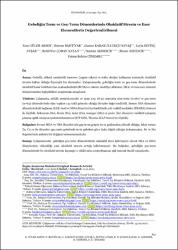Gebeliğin Term ve Geç-Term Dönemlerinde Oksidatif Stresin ve Eser Elementlerin Değerlendirilmesi

View/
Date
2023Author
Güler Aksoy, EsraBahtiyar, Nurten
Karakullukçu Savaş, Gamze
Sevinç Avşar, Leyla
Çoban Kayan, Betül Nur
Akdemir, Nermin
Aydemir, Birsen
Cinemre, Fatma Behice
Metadata
Show full item recordAbstract
Amaç: Gebelik, yüksek metabolik turnover (yapım-yıkım) ve doku oksijen kullanımı nedeniyle oksidatif
stresin hakim olduğu fizyolojik bir durumdur. Çalışmamızda, gebeliğin term ve geç-term dönemlerinde
oksidatif hasar belirteci olan malondialdehit (MDA) ve iskemi-modifiye albümin (IMA) ve bazı eser element
düzeylerindeki değişiklikleri araştırmak amaçlandı.
Yöntem: Çalışmada, sefalik prezentasyonlu ve anne yaşı 18-40 arasında olan term (n=80) ve geç-term
(n=64) dönemlerinde olan toplam 144 tekil gebenin olduğu bireyler değerlendirildi. Serum IMA düzeyleri
albumin kobalt bağlama (CAB) testi ve MDA düzeyleri tiyobarbitürik asit reaktif maddeler (TBARS) yöntemi
ile ölçüldü. Selenyum (Se), demir (Fe), bakır (Cu), mangan (Mn) ve çinko (Zn) düzeyleri indüktif eşleşmiş
plazma optik emisyon spektrofotometresi (ICP-OES, Thermo iCAP-6000) ile ölçüldü.
Bulgular: Serum MDA ve IMA düzeylerinin geç-term grupta term grubundan yüksek olduğu, fakat serum
Zn, Cu ve Se düzeyleri geç-term gebelerde term gebelere göre daha düşük olduğu bulunmuştur. Fe ve Mn
değerlerinde anlamlı bir değişim bulunmamaktadır.
Sonuç: Çalışmamızda, gebeliğin geç-term dönemlerinde oksidatif stres belirteçleri olarak IMA ve MDA
düzeylerinin yükseldiği yani oksidatif stresin arttığı belirlenmiştir. Bu bulgular, gebeliğin geç-term
dönemlerinde bu oksidatif stresin kaynağı ve etkilerinin araştırılmasına ışık tutacak öncül sonuçlardır. Aim: Pregnancy is a physiological condition characterised by oxidative stress due to high metabolic turnover
(synthesis-breakdown) and tissue oxygen use. Our study aimed to investigate the changes in the levels of
malondialdehyde (MDA), ischemia-modified albumin (IMA), and some trace elements, which are markers
of oxidative damage, during the term and late-term periods of pregnancy.
Method: In our study, 144 singleton pregnant women with cephalic presentation and maternal age between
18-40 years in the term (N=80) and late-term (N=64) periods were evaluated. Serum IMA levels were
measured by the albumin cobalt binding (CAB) test and MDA levels were measured by the thiobarbituric
acid reactive substances (TBARS) method. Selenium (Se), iron (Fe), cobalt (Co), manganese (Mn), and zinc
(Zn) levels were measured using an inductively coupled plasma optical emission spectrophotometer (ICPOES, Thermo iCAP-6000).
Results: Serum MDA levels and IMA levels were found to be higher in the late-term group than in the term
group, but serum Zn, Cu, and Se levels were lower in late-term pregnant women than in term pregnant
women. There was no significant change in Fe and Mn values.
Conclusion: In our study, it was determined that IMA and MDA levels, as oxidative stress markers,
increased in the late-term periods of pregnancy, i.e., oxidative stress increased. These findings are
preliminary results that will shed light on investigating the source and effects of this oxidative stress in the
late-term periods of pregnancy.
















